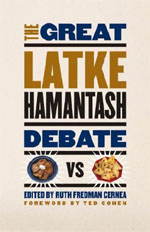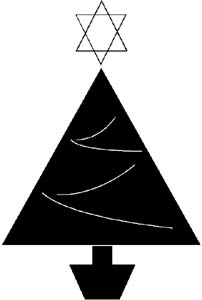 Chag sameach! If you’re over 8 and don’t yet have children of your own, it’s likely that Purim is off your radar as far as Jewish holidays go. Your memory hearkens back to your childhood synagogue carnival, where hordes of little Hamans with black eyeliner goatees spazzed with their crazy loud groggers, and maybe some crumbly dry hamentaschen was forced upon you by the Hadassah treasurer, and even though there’s some killer Purim party happening near you tonight, you’re thinking “Nah, I’m gonna stay in and watch ‘The Apprentice.'”
Chag sameach! If you’re over 8 and don’t yet have children of your own, it’s likely that Purim is off your radar as far as Jewish holidays go. Your memory hearkens back to your childhood synagogue carnival, where hordes of little Hamans with black eyeliner goatees spazzed with their crazy loud groggers, and maybe some crumbly dry hamentaschen was forced upon you by the Hadassah treasurer, and even though there’s some killer Purim party happening near you tonight, you’re thinking “Nah, I’m gonna stay in and watch ‘The Apprentice.'”
You need to get over it, though, really. Purim rocks sooo hard. Not only is it a story of intrigue and mystery set in ancient Persia, there’s always a new way to interpret the Megillah. For instance, I always thought Queen Vashti should be admired for refusing to dance nekkid for that pig King Ashauerus and his drunk buddies, but then I read an article by Rebbetzin Tzipporah Heller, who shows that Vashti wasn’t such a stand-up feminist heroine after all.
And since mixing it up is what Purim’s all about (the sages say we’re supposed to party ’til we can’t tell the difference between good and evil,) El Yenta Man has promised to fulfill the family tradition of cross-dressing. It all began as a “real men aren’t afraid to show their feminine side” type of dare, and he caused such a sensation last year as Queen Esther that our congregation president asked him to join the board right then and there. He wants to go as Vashti this year “’cause she’s sexier,” he says, but wait ’til I tell him she’s a huge beeyotch to boot.
So go find some Jews tonight, toss a few back; if you’re anywhere near San Francisco you’re so stoked because Matisyahu and Perry Farrell are headlining Purimpalooza at Ruby Skye, which lets you know right there that Purim is the hippest of hipster holidaze, yo.
And go in costume, even if you’re just wearing this stick figure t-shirt that distills the Purim shpiel down to the remedial basics. But be careful of that Queen with the big shoulders she’s taken.

 Oh, it may feel like an ordinary winter Monday, but for our people it’s the 15th day in the month of Shevat, the New Year For Trees.
Oh, it may feel like an ordinary winter Monday, but for our people it’s the 15th day in the month of Shevat, the New Year For Trees.  You’d need one of these for the big a** doorpost of your house.
You’d need one of these for the big a** doorpost of your house.  However, after reading
However, after reading  Friday afternoon it happens.
Friday afternoon it happens.  The
The  The Yenta is spending a highly “traditional” Thanksgiving holiday in Scottsdale, AZ with all members of the immediate family including the Bubbe, who we roll in from the nursing home every day so she can bask in the glow created by sparks of toys banged together by shrieking great-grandchildren.
The Yenta is spending a highly “traditional” Thanksgiving holiday in Scottsdale, AZ with all members of the immediate family including the Bubbe, who we roll in from the nursing home every day so she can bask in the glow created by sparks of toys banged together by shrieking great-grandchildren. Another
Another  I must say I’m pleased with the rebellion against Christmas as the default wintertime holiday in this culture.
I must say I’m pleased with the rebellion against Christmas as the default wintertime holiday in this culture. A recent gathering of the National Organization of American Mohelim
A recent gathering of the National Organization of American Mohelim